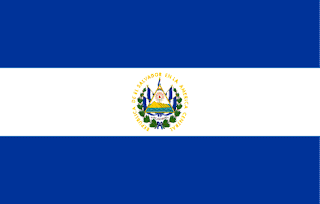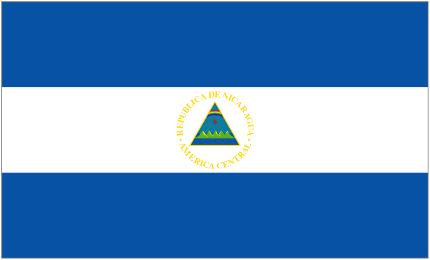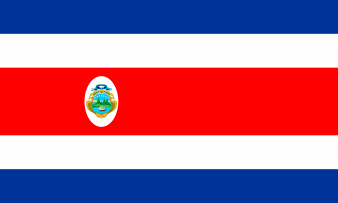OK, let´s begin:
Belize
The flag of Belize is a continued version of the earlier flag of British Honduras (the name of Belize during the British colonial period).
British Honduras obtained a coat of arms on January 28, 1907, which formed the basis of the badge used on British ensigns. The coat of arms recalls the logging industry that first led to British settlement there. The figures, tools, and mahogany tree represent this industry. From 1950 onward an unofficial national flag was in use. It was blue, with a modified version of the arms on a white disc in the centre (sometimes a blank white circle was used as the coat of arms was difficult to draw). The national motto, Sub Umbra Floreo, meaning “I Flourish in the Shade”, is written in the lower part of the coat of arms.
Guatemala
The flag of Guatemala features two colors: sky blue and white. The two sky blue stripes represent the fact that Guatemala is a land located between two oceans, the Pacific Ocean and the Atlantic Ocean (Caribbean sea); and the sky over the country (see Guatemala's National Anthem). The white color signifies peace and purity.
In the center of the flag is the Guatemalan coat of arms. It includes the Resplendent Quetzal, the national bird of Guatemala that symbolizes liberty; aparchment scroll bearing the date of Central America's independence from Spain, 15 September 1821; crossed rifles, indicating Guatemala's willingness to defend itself by force if need be; a bay laurel crown, the symbol for victory; and crossed swords, representing honor.
Honduras
The flag consists of three horizontal bands of equal width with an overall length:width ratio of 2:1. The two outer cerulean bands represent the Pacific Ocean and the Caribbean Sea. The inner white band represents the land between the ocean and the sea and the peace and prosperity of its people. The five cerulean five-pointed stars arranged in an X pattern centered in the white band represent the five nations of the former Federal Republic of Central America (El Salvador, Costa Rica, Nicaragua, Honduras, and Guatemala) and the hope that the nations may form a union again.
( I particularly love this flag, first because it is the one of my country, then because is simple and nice, and most importantly, because it represent the Central American union.)
El Salvador
The flag of El Salvador was inspired by the flag of the Federal Republic of Central America, and by the flag of Argentina, the country that sent one of the first fleets to help consummate the independence of Central American republics from Spain.
There are two versions of the flag, one containing the national coat of arms and the other the words "DIOS UNION LIBERTAD" (Spanish: God, Union, Liberty). The one bearing the coat of arms is used by the government and state organizations. The other version is used for civil purposes. Both flags have a 3:5 aspect ratio. The actual blue and white stripes in flag are based on the importance of añil exports, añil was commonly used as a source for indigo dye.
Nicaragua
The coat of arms used today contains the name of the state, Republica de Nicaragua, whereas in 1823 the title was Provincias Unidas del Centro de America. The decision to revert to the emblems used by the United Provinces of Central America was taken in 1908 and reflected Nicaragua's aspirations for the rebirth of the political entity formed by the 5 nations. Except for the text around the arms, the flag is very similar to that of the United Provinces of Central America. The 5 volcanoes represent the original 5 member states, the Cap of Liberty represents national freedom, and the rays of the sun and the rainbow are symbolic of the bright future.
Costa Rica
The flag was officially adopted on November 27, 1906, including a slight modification to the placement and design of the entrenched coat of arms. The flag was updated to reflect concurrent modifications to the national coat of arms in 1964 and 1998
Panama
The flag of Panama was made by Maria Ossa de Amador. It has been officially adopted by the "ley 48 de 1925". the flag is celebrated on November 4, one day after Panamanian independence from Colombia.
The stars and quarters are said to stand for the rival political parties, and the white for the peace in which they operate. Blue was the color of the Conservatives, and red the color of the Liberals. The Panamanian government officially described the flag in Law 15 of December 1949, as follows: The Flag of the Republic consists thus of a divided rectangle of four quarters: the upper field close to the pole white with a blue star of five points; the upper field further from the pole, red; the lower field near the pole, blue; and the lower one further from the pole, white with a red star of five points.
This flag was to reflect the political situation of the time. The blue was intended to represent the Conservative Party and the red to represent the Liberal Party. The white was intended to stand for peace and purity; the blue star stands for the purity and honesty of the life of the country; the red star represents the authority and law in the country; and together the stars stand for the new republic.








No hay comentarios:
Publicar un comentario